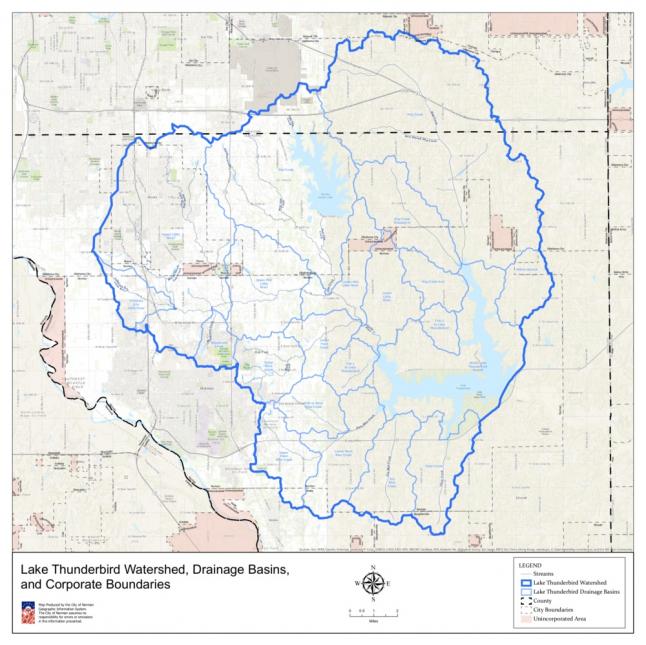What is a watershed?
Before we dive into the Lake Thunderbird watershed, let's discuss what a watershed actually is. A watershed is an area of land that catches and drains water into a creek, stream, or lake. Everyone lives, works, and plays in a watershed! This means that everything we do has the potential to affect our water quality.
Lake Thunderbird and Its Watershed

Lake Thunderbird was built by the Bureau of Reclamation to provide drinking water to Del City, Midwest City and Norman, with construction beginning in 1962 and ending in 1965. First known as the Norman Reservoir, then Little River Reservoir, its final name was given by contest winner, Mrs. Louie L. McKenzie of Oklahoma City, who based the name on the Native American legend of the mythological creature, the Thunderbird, a powerful spirit in the form of a bird.
While several cities contribute stormwater runoff to the lake, Norman is the only one that also drinks from it.In other words, Norman residents drink our stormwater runoff! Due to the level of pollutants in the lake, it was deemed a Sensitive Water Supply in 2002. From there, it was placed on the Oklahoma Department of Environmental Quality's (ODEQ) 303(d) list, a list that denotes those waterbodies within the state that do not meet water quality standards. The lake was shown to be impaired by sediment and nutrients, like nitrogen and phosphorus. In 2013, ODEQ established a Total Maximum Daily Load (TMDL) for the watershed in an effort to improve the lake's water quality. As the largest contributors of stormwater runoff to the lake, Moore, Norman and Oklahoma City had to develop and implement Compliance and Monitoring Plans which spell out how each city will meet the requirements of the TMDL. Norman's Compliance and Monitoring Plan was adopted by City Council on October 25, 2016, via Resolution No. R-1617-41.
What is a Total Maximum Daily Load or TMDL
A TMDL is a calculation of the maximum amount of a pollutant that a waterbody can receive and still meet water quality standards. A TMDL is developed after a waterbody is found to be impaired through water sampling and analysis. It sets limits on various sources of pollution such as industrial facilities, municipal wastewater treatment plants, or municipal storm sewer systems in an effort to clean up the water and make sure water quality standards are met.
A TMDL has been developed for the Lake Thunderbird watershed. The pollutants of concern in this watershed are nitrogen, phosphorus, and sediment. Nitrogen and phosphorus comes from fertilizers and pet waste. Sediment comes from construction sites, agricultural practices, and streambank erosion. We will all have to work together to reduce the amount of these pollutants being discharged to Lake Thunderbird by reducing the amount of fertilizer we use, picking up after our pets, and ensuring that our septic systems are properly maintained.
How is the City dealing with the Lake Thunderbird Watershed TMDL?
The Oklahoma Department of Environmental Quality required the City to develop compliance and monitoring plans to describe how we plan to meet our requirements to reduce the amount of nitrogen, phosphorus, and sediment in our stormwater runoff. These plans were adopted by City Council on October 27, 2016, and include a 5-year schedule of monitoring and other activities to meet these requirements.
City of Norman Lake Thunderbird Compliance and Monitoring Plans
Where can I find monitoring data?
2017
2018
2019
2020
2021
2022
2023
August 2023
September 2023
October 2023
November 2023
December 2023
